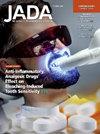Different daily times for at-home bleaching with 10% carbamide peroxide
IF 3.1
2区 医学
Q1 DENTISTRY, ORAL SURGERY & MEDICINE
引用次数: 0
Abstract
Background
This single-blind, noninferiority trial evaluated whether 10% carbamide peroxide (CP) applied for 2 or 4 hours daily is noninferior to 8 hours.
Methods
A total of 120 healthy adults, with teeth shade A2 or darker, were randomly allocated to 3 groups (n = 40). All participants used 10% CP gel in a bleaching tray for 2, 4, and 8 hours daily for 14 days, with the option to extend treatment if they were dissatisfied. Color change was measured using a spectrophotometer and shade guides at baseline, every 5 days, and 1 month posttreatment. Risk and intensity of tooth sensitivity (TS) were assessed daily using a 0 through 10 visual analog scale. Satisfaction was recorded via a Likert scale wherein 1 corresponded to very dissatisfied and 7 corresponded to very satisfied and the Orofacial Esthetic Scale. Noninferiority was tested for color change using the 1976 formula (ΔEab) at 1 month postbleaching (primary outcome), color change using the 2000 formula (ΔE00), Whiteness Index, and shade guide units, whereas TS and satisfaction were analyzed with χ2, analysis of variance, Kruskal-Wallis, and Friedman tests.
Results
Color change in ΔEab (2 vs 8 h: mean difference, −0.6; 90% CI, −2.1 to 1.0, 4 vs 8 h: mean difference, 0.0; 90% CI, −1.6 to 1.6) and ΔE00 values for shorter durations were noninferior to 8 hours at 1 month. Whiteness Index results were inconclusive. TS risk and intensity were similar (P > .05), and patient satisfaction improved across all groups similarly (P > .05).
Conclusions
Shorter 2- and 4-hour daily bleaching with 10% CP is noninferior to the 8-hour protocol.
Practical Implications
Shorter periods of at-home bleaching (2 and 4 h) can be prescribed depending on the patient's availability or preferences without jeopardizing the bleaching efficacy. This clinical trial was registered at Registro Brasileiro de Ensaios Clínicos (RBR-10vvfpcm).
10%过氧化脲在家中漂白的不同每日次数:一项随机、单盲、非劣效性对照试验。
背景:这项单盲、非劣效性试验评估了10%过氧化脲(CP)每日应用2小时或4小时是否优于8小时。方法:健康成人120例,牙色A2或更深,随机分为3组(n = 40)。所有参与者在漂白托盘中每天使用10% CP凝胶2、4和8小时,持续14天,如果他们不满意,可以选择延长治疗时间。在基线、每5天和治疗后1个月,使用分光光度计和阴影指南测量颜色变化。每天使用0到10的视觉模拟量表评估牙齿敏感(TS)的风险和强度。满意度是通过李克特量表记录的,其中1代表非常不满意,7代表非常满意和口腔面部美学量表。使用1976公式(ΔEab)对漂白后1个月(主要结局)的颜色变化进行非劣效性检验,使用2000公式(ΔE00)、白度指数和色度指导单位对颜色变化进行检验,而使用χ2、方差分析、Kruskal-Wallis和Friedman检验对TS和满意度进行分析。结果:ΔEab颜色变化(2 vs 8 h:平均差值-0.6;90% CI, -2.1至1.0,4 vs 8 h:平均差值,0.0;90% CI, -1.6至1.6)和ΔE00值在1个月时较短的持续时间不低于8小时。白度指数结果不确定。TS风险和强度相似(P < 0.05),患者满意度在所有组中均有相似的改善(P < 0.05)。结论:较短的每日2小时和4小时漂白,10% CP不低于8小时方案。实际意义:在不影响漂白效果的情况下,可根据患者的可用性或偏好规定较短的居家漂白时间(2和4小时)。该临床试验已在Registro Brasileiro de enaios Clínicos (RBR-10vvfpcm)注册。
本文章由计算机程序翻译,如有差异,请以英文原文为准。
求助全文
约1分钟内获得全文
求助全文
来源期刊

Journal of the American Dental Association
医学-牙科与口腔外科
CiteScore
5.30
自引率
10.30%
发文量
221
审稿时长
34 days
期刊介绍:
There is not a single source or solution to help dentists in their quest for lifelong learning, improving dental practice, and dental well-being. JADA+, along with The Journal of the American Dental Association, is striving to do just that, bringing together practical content covering dentistry topics and procedures to help dentists—both general dentists and specialists—provide better patient care and improve oral health and well-being. This is a work in progress; as we add more content, covering more topics of interest, it will continue to expand, becoming an ever-more essential source of oral health knowledge.
 求助内容:
求助内容: 应助结果提醒方式:
应助结果提醒方式:


